The Gund Gallery at Kenyon College
Gambier, OH, USA
4 October–15 December 2019
Kitchener-Waterloo Art Gallery
Kitchener-Waterloo, ON, Canada
30 May–9 August 2020
Morris and Helen Belkin Art Gallery
Vancouver, BC, Canada
8 September–6 December 2020
Kamloops Art Gallery
Kamloops, BC, Canada
17 April–3 July 2021
How can a score be a call and tool for decolonization? Curated by Candice Hopkins (Tlingit) and Dylan Robinson (Stó:l?), Soundings: An Exhibition in Five Parts features newly commissioned scores and sounds for decolonization by Indigenous artists who attempt to answer this question. The scores take the form of video, objects, graphic notation, museological objects, and written instructions. At different moments during the exhibition these scores are activated by musicians, dancers, performers and members of the public, gradually filling the gallery and surrounding public spaces with sound and action. Soundings turns up the volume on voices that don’t always have the stage allowing their actions to reverberate through gallery walls and within visitors’ bodies. The exhibition is accumulative, gaining new artists and players throughout the run of the show. Soundings artists include Raven Chacon and Cristóbal Martínez, Sebastian De Line, Camille Georgeson-Usher, Cheryl L’Hirondelle, Kite, Tanya Lukin Linklater, Ogimaa Mikana, Peter Morin, Lisa C. Ravensbergen, Heidi Senungetuk, Olivia Whetung and Tania Willard.
Soundings is accompanied by a postcard publication of scores designed by Sébastien Aubin and a public listening series entitled “Against Hungry Listening,” which will include notable composers, musicians, scholars and artists discussing de-colonial, queer, feminist, black and Indigenous-specific forms of listening.
Public art installations by Raven Chacon, Camille Georgeson-Usher, Ogimaa Mikana and a curatorial score written by Dylan Robinson are on view on Queen’s University main campus.These outdoor artworks are generously supported through the Isabel & Alfred Bader Fund of Bader Philanthropies and the George Taylor Richardson Memorial Fund at Queen’s University.
Soundings is affiliated with The Isabel Bader Centre for the Performing Arts’ concurrent Ka’tarohkwi Festival of Indigenous Arts. Visit their website for more details on a diverse array of performances by acclaimed Indigenous artists working across theatre, dance, music, film and performance art.
Soundings is one of the 200 exceptional projects funded through the Canada Council for the Arts’ New Chapter program. With this $35M investment, the Council supports the creation and sharing of the arts in communities across Canada.
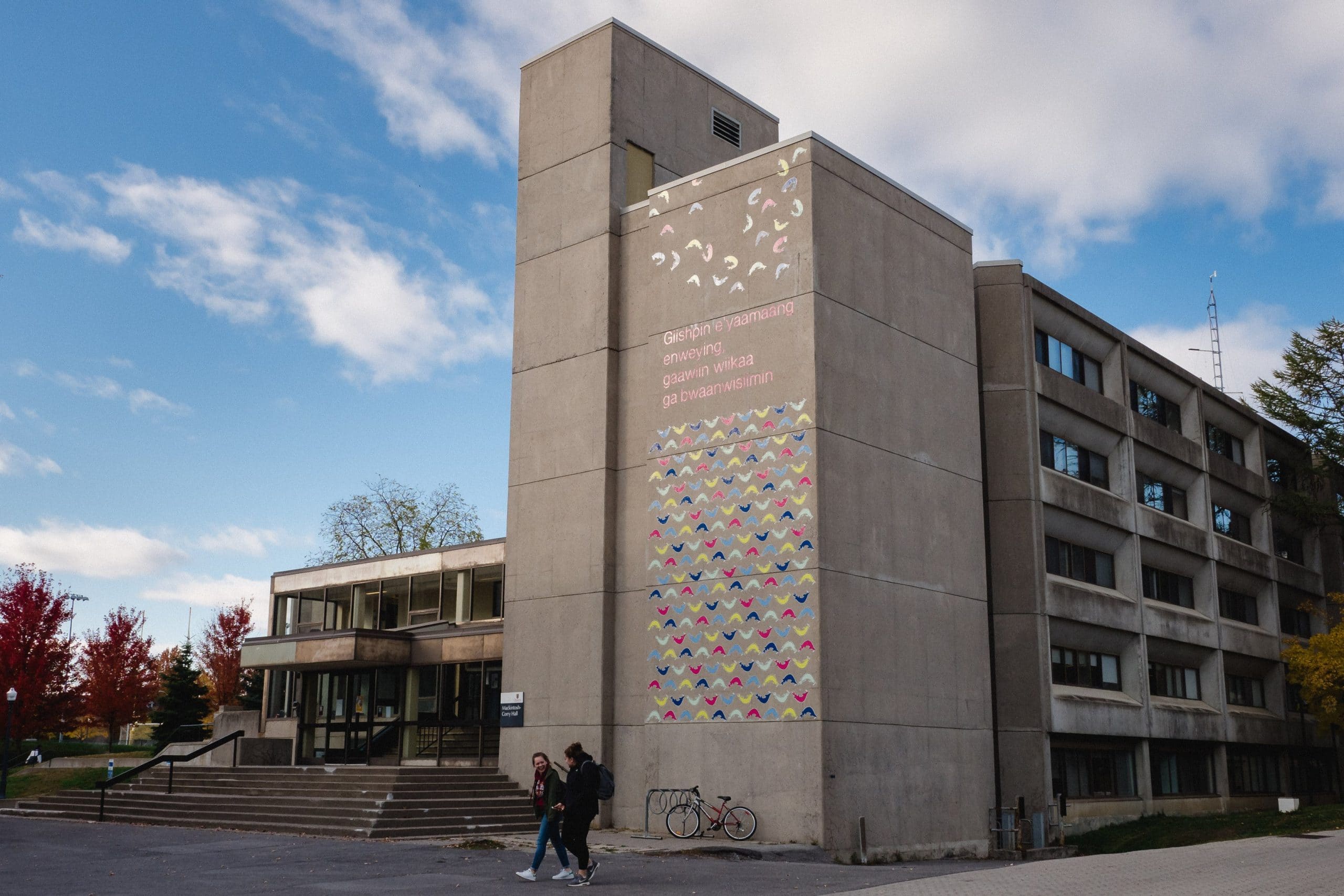
One of three outdoor installations by artists for Soundings: An Exhibition in Five Parts, an exhibition at Agnes Etherington Art Centre: Ogimaa Mikana, Never Stuck, 2018, vinyl transfer.

Raven Chacon and Cristóbal Martínez, A Song Often Played on the Radio, 2018, digital video from the exhibition Soundings: An Exhibition in Five Parts.
Thursday Tour featuring Soundings: An Exhibition in Five Parts
Thursday 24 January, 12:15–1 pm
NOW Society Ensemble
Friday 25 January, 1–3:30 pm
Against Hungry Listening
1, 7, 14, 28 February
Open Devising Process for Wani’/Lost featuring Lisa C. Ravensbergen
6–10 February and 16–17 March
10 am–3:30 pm weekdays, 1–3:30 pm weekends
NDN Love Songs performed by Parmela Attariwala
Thursday 14 February, 11:30–12:30 pm
Open Rehearsals with Tanya Lukin Linklater
16–21 March
Surrounded/Surrounding
Thursday 21 March, 6:30 pm
Procession with Tania Willard and Performance by Jeneen Frei Njootli
Sovereign Listening Space
Saturday 23 March, 1–5 pm
Soundings will be closed to the public but other shows will be available.
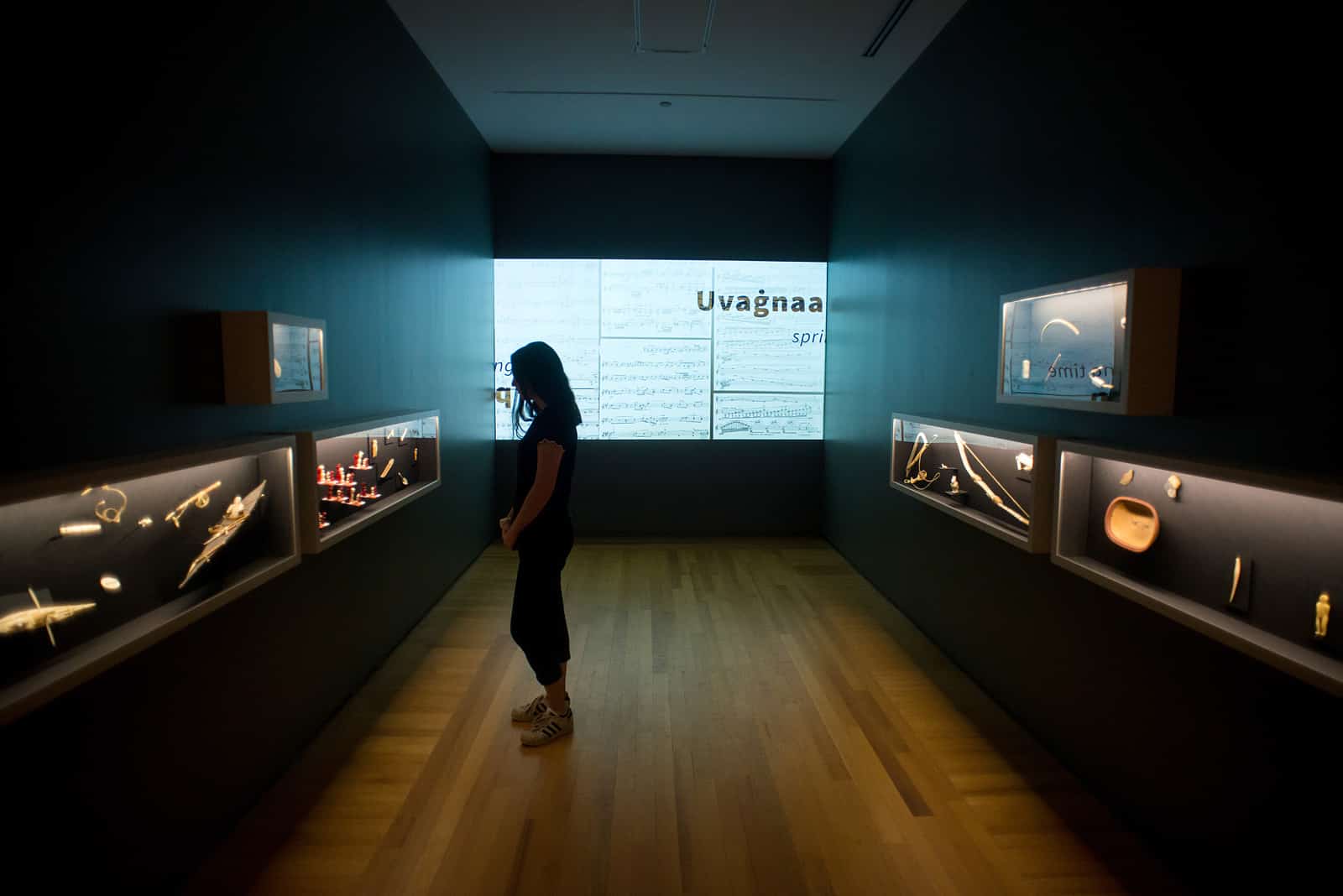
Heidi Senungetuk’s Qutaaŋuaqtuit: Dripping Music with thirty-three cultural belongings displayed with playful dramatic flare at Agnes Etherington Art Centre as part of Soundings: An Exhibition in Five Parts.
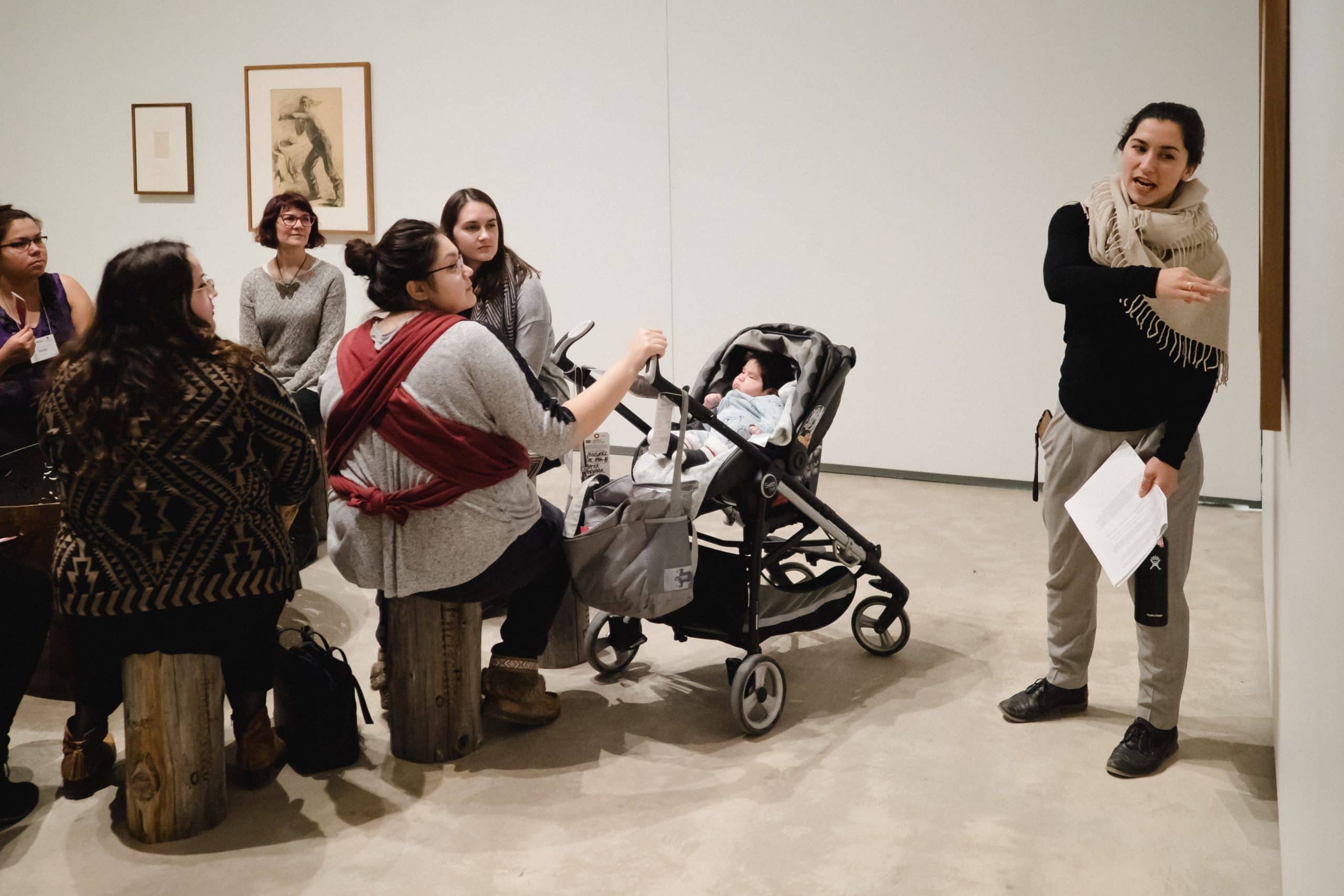
Young mothers, serving as Mama-We mentors in their communities, spent two days at Agnes Etherington Art Centre touring the exhibition Soundings: An Exhibition in Five Parts, learning about works in the collection and gaining skills in two Studio workshops.
Raven Chacon is a composer, performer and installation artist from Fort Defiance, Navajo Nation. As a solo artist, collaborator, or with Postcommodity, Chacon has exhibited or performed at Whitney Biennial, documenta 14, REDCAT, Musée d’art Contemporain de Montréal, San Francisco Electronic Music Festival, Chaco Canyon, Ende Tymes Festival, 18th Biennale of Sydney, and The Kennedy Center. Every year, he teaches 20 students to write string quartets for the Native American Composer Apprenticeship Project (NACAP). He is the recipient of the United States Artists fellowship in Music, The Creative Capital award in Visual Arts, The Native Arts and Cultures Foundation artist fellowship, and the American Academy’s Berlin Prize for Music Composition. He lives in Albuquerque, New Mexico, and Toronto, ON.
Cristóbal Martínez is an artist and publishing Liberal Arts and Sciences scholar. He has been a member of the interdisciplinary artist collective Postcommodity since 2010, and founded the artist-hacker performance ensemble Radio Healer in 2003. In 2015 Martinez completed his PhD in Rhetoric, Composition, and Linguistics at Arizona State University, and is currently the Chair of Art and Technology at the San Francisco Art Institute.
Sebastian De Line is a queer, trans artist and scholar of Haudenosaunee-Métis-Cantonese descent who was born in Burnaby, BC, on the unceded territories of the Musqueam, Squamish and Tsleil-Waututh nations. He/they hold a BFA in Autonomous Fine Art from the Gerrit Rietveld Academy, an MA in Art Praxis from the Dutch Art Institute and is currently a PhD Candidate in Cultural Studies at Queen’s University (situated on traditional Haudenosaunee and Anishinaabe territory). His/their work seeks a non-spectacular form of art that enables an intimacy with the spectator – encompassing drawing, painting, sculptural installation and storytelling.
Camille Georgeson-Usher is a Skwxwú7mesh / Hul’q’umi’num / Sahtu Dene/Scottish scholar, artist and writer from Galiano Island, British Columbia, which is of the Pune’laxutth’ (Penelakut) Nation. Usher completed her MA in Art History at Concordia University. Her thesis, “more than just flesh: the arts as resistance and sexual empowerment,” focused on how the arts may be used as a tool to engage Indigenous youth in discussions of health and sexuality, drawing predominantly on the work of Qaggiavuut!, an Arctic performing arts group, for her case study. She is currently a PhD student in Cultural Studies at Queen’s University and has been awarded the Joseph-Armand Bombardier Canada Graduate Scholarships-Doctoral for her research-creation work around urban Indigenous experiences within Indigenous arts collectives and other groups activating public spaces through gestures both little and big. She has been awarded the 2018 Canadian Art Writing Prize and has been lucky to develop her installation-based artistic practice through acts of love and care in collaboration with filmmaker Asinnajaq.
Kite aka Suzanne Kite is an Oglala Lakota performance artist, visual artist and composer raised in Southern California, with a BFA from CalArts in music composition, an MFA from Bard College’s Milton Avery Graduate School, and is a PhD student at Concordia University and Research Assistant for the Initiative for Indigenous Futures. Her research is concerned with contemporary Lakota epistemologies through research-creation, computational media, and performance practice. Recently, Kite has been developing a body interface for movement performances, carbon fiber sculptures, immersive video and sound installations, as well as co-running the experimental electronic imprint, Unheard Records.
Cheryl L’Hirondelle (Cree/Half Breed; German/Polish) is an award-winning and community-engaged interdisciplinary artist, singer/songwriter and critical thinker whose family is from Papaschase First Nation / amiskwaciy wâskahikan (Edmonton, AB) and Kikino Metis Settlement. Her work investigates and attempts to articulate an intersection of nêhiyawin (Cree worldview) with contemporary time-place by incorporating sound, Indigenous language(s), music, plus old and new technologies. Her current ongoing projects include: Why the Caged Bird Sings, a collaborative songwriting project with incarcerated women, men and detained youth; nîpawiwin ohci, a series of immersive installations created to evoke embodied concepts towards solidarity and inclusion; yahkâskwan mîkiwahp (aka light tipi) ? a participatory action ‘virtual’ tipi made of light and sage smudge (with Joseph Naytowhow); and Singing Land – a multi-iterative international songwriting/sonic mapping project where she “sings land” as a process of personal treaty-making. She is currently a PhD candidate at SMARTlab/UCD in Dublin, Ireland.
Tanya Lukin Linklater’s performances in museums, videos and installations have been exhibited in Canada, the United States and abroad. Her work centres Indigenous knowledge production in and through orality, conversation and embodied practices, including dance. She considers That which sustains us a conceptual and affective line within her work, alongside histories and structural violences that Indigenous peoples continue to respond to. In 2017, as a member of Wood Land School, she participated in Under the Mango Tree – Sites of Learning, a gathering for documenta14 in Athens and Kassel. In 2018, Lukin Linklater will present a commissioned performance for Art for a New Understanding: Native Voices, 1950s to Now at Crystal Bridges Museum of American Art. Lukin Linklater was the inaugural recipient of the Wanda Koop Research Fund administered by Canadian Art. She originates from the Native Villages of Afognak and Port Lions in Alaska and is based in Northern Ontario.
Ogimaa Mikana is an artist collective founded by Susan Blight (Anishinaabe, Couchiching) and Hayden King (Anishinaabe, Gchi’mnissing) in January 2013. Through public art, site-specific intervention and social practice, they assert Anishinaabe self-determination on the land and in the public sphere.
Peter Morin is a Tahltan Nation artist and curator. Throughout his artistic practice, Morin investigates the impact zones that occur when Indigenous practices collide with Western-settler colonialism. Morin’s artworks are shaped, and reshaped, by Tahltan epistemological production and often takes the form of performance interventions. In addition to his exhibition history, Morin has curated exhibition for the Museum of Anthropology, Western Front, Bill Reid Gallery and Burnaby Art Gallery. In 2016, Morin received the Hnatyshyn Foundation Award for Outstanding Achievements by a Canadian Mid-Career Artist. Morin holds a tenured appointment in the Faculty of Arts at the Ontario College of Art and Design University in Toronto.
Lisa C. Ravensbergen is an established multi-disciplinary creator and writer, and also works across Turtle Island as a Jessie-nominated actor and dramaturge, director and dancer. A tawny mix of Ojibwe/ Swampy Cree and English/ Irish, Ravensbergen resides on unceded Coast Salish territory in Vancouver, BC. She supplements her eclectic theatre practice with the delights of motherhood and the challenges of self-produced works. Ravensbergen is an Associate Artist with Full Circle and Playwright-in-Residence with Delinquent Theatre. She holds undergraduate degrees from TWU and SFU and is currently in the final year of her MA in Cultural Studies at Queens.
Heidi Aklaseaq Senungetuk is the granddaughter of Helen Aklaseok and Willie Senungetuk, and the daughter of Ron and Turid Senungetuk. She is a violinist and scholar of ethnomusicology. Currently, she serves the University of Alaska Anchorage as the first postdoctoral fellow in Alaska Native Studies. She continues to perform with the Kingikmiut Dancers and Singers of Anchorage and with the Anchorage Symphony Orchestra.
Olivia Whetung works in beadwork, printmaking, and digital media. Her work explores acts of/active native presence, and is informed in part by her experiences as a language learner. Whetung is from the area now called the Kawarthas and presently resides on Chemong Lake.
Tania Willard, of Secwe?pemc and settler heritage, works within the shifting ideas around contemporary and traditional, often working with bodies of knowledge and skills that are conceptually linked to her interest in intersections between Aboriginal and other cultures. Public Art projects include, Rule of the Trees, a public art project at Commercial Broadway sky train station, in Coast Salish Territories in Vancouver BC, and If the Drumming Stops, with artist Peter Morin, on the lands of the Papaschase First Nation in Edmonton, AB. Willard’s ongoing collaborative project BUSH gallery is a conceptual land-based gallery grounded in Indigenous knowledges and relational art practices. Willard’s current research constructs a land rights aesthetic through intuitive archival acts and land-based practices.
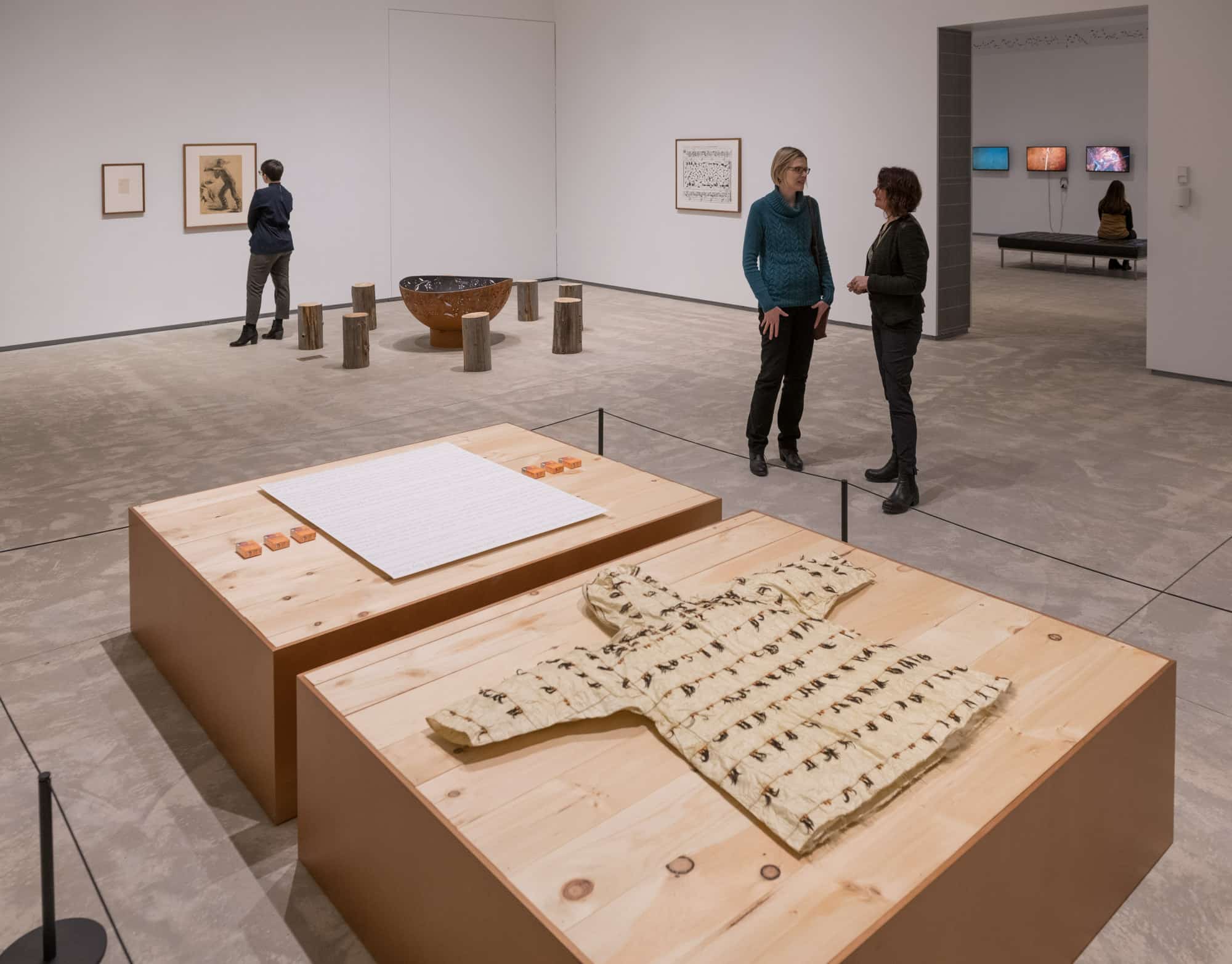
Installation views of Soundings: An Exhibition in Five Parts at Agnes Etherington Art Centre, 5 January–7 April 2019.
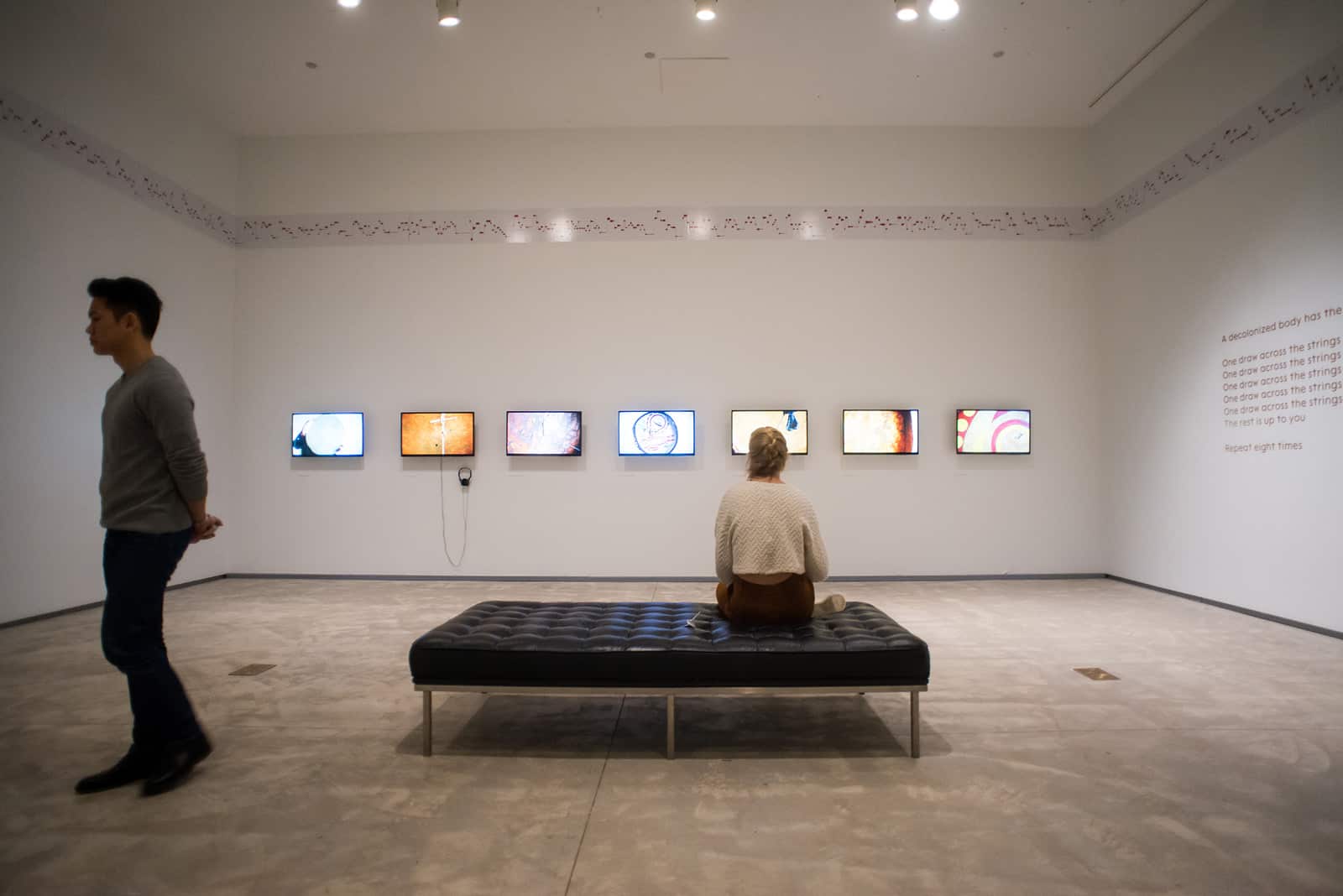
Candice Hopkins is a curator and writer originally from Whitehorse, Yukon. She is Senior Curator of the Toronto Biennial of Art and co-curator of the SITE Santa Fe biennial, Casa Tomada. She was a part of the curatorial team for documenta 14 in Athens, Greece and Kassel, Germany and a co-curator of the major exhibitions Sakahàn: International Indigenous Art, Close Encounters: The Next 500 Years, and the 2014 SITElines biennial, Unsettled Landscapes in Santa Fe, New Mexico. Her writing is published widely and her recent essays and presentations include “Outlawed Social Life” for South as a State of Mind and Sounding the Margins: A Choir of Minor Voices at Small Projects, Tromsø, Norway. She has lectures internationally including at the Witte de With, Tate Modern, Dak’Art Biennale, Artists Space, Tate Britain and the University of British Columbia. She is the recipient of numerous awards including the Hnatyshyn Foundation Award for Curatorial Excellence in Contemporary Art and the 2016 the Prix pour un essai critique sur l’art contemporain by the Foundation Prince Pierre de Monaco. She is a citizen of Carcross/Tagish First Nation.
Dylan Robinson is a xwélméxw artist and writer of Stó:l? descent, and the Canada Research Chair in Indigenous Arts at Queen’s University. His current work focuses on the return of Indigenous songs to communities who were prohibited by law to sing them as part of the Indian Act from 1882?1951. Robinson’s previous publications include the edited volumes Music and Modernity Among Indigenous Peoples of North America (2018); Arts of Engagement: Taking Aesthetic Action in and Beyond the Truth and Reconciliation Commission of Canada (2016) and Opera Indigene (2011). His monograph, Hungry Listening, is forthcoming in 2019 with Minnesota University Press.